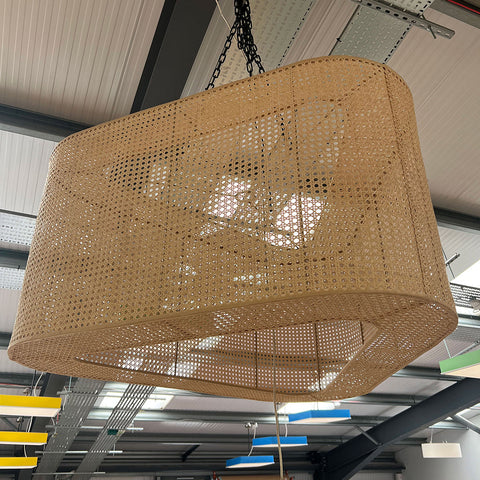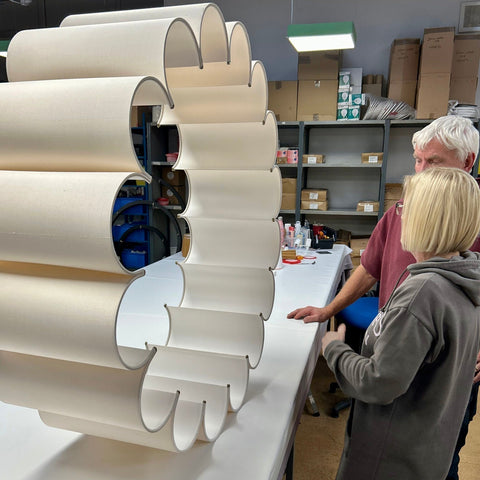Rattan is having a moment
It is difficult to scroll through a mood board, magazine or marketplace without seeing rattan. It appears in softly curved chairs, woven screens, lighting accents and coffee tables. Rattan is earthy and effortless. It feels light in the room and light on the conscience. Designers and brands alike are quick to label it as natural and sustainable. But what lies beneath the texture?
In my work with interior designers, specifiers and manufacturers, I often encounter materials that rise and fall with the fashion of the moment. Some fade gently, others are discarded faster than they were embraced. Rattan may fall into the latter category unless we understand what we are truly working with.
 Woven Rattan from certified sustainable sources
Woven Rattan from certified sustainable sources

Rattan lampshades in production at Iberian Lighting HQ
What Rattan really is
Rattan is not a tree. It is a climbing palm that grows like a vine throughout tropical rainforests, especially in Southeast Asia. It uses other trees for support and can grow to extraordinary lengths. When harvested, it is strong yet pliable, making it ideal for furniture and woven pieces.
Its popularity stems from more than appearance. It fits perfectly into the contemporary desire for homes that feel organic, relaxed and aligned with nature. But this alignment is often superficial.
The ecological reality
Rattan is most often harvested from the wild. It is rarely cultivated on plantations. Harvesters must enter deep forest areas to find and cut the vines. In the process, surrounding trees and undergrowth are frequently disturbed or cut to access the canes.

A worker cuts rattan
Although rattan itself grows relatively fast, the damage caused during harvesting has longer-term consequences such as:
Forest disruption: According to the World Wide Fund for Nature, uncontrolled harvesting of rattan contributes to forest degradation and biodiversity loss. The cutting of support trees and undergrowth harms delicate ecosystems.
Pollution from processing: To prepare rattan for use, it is typically treated with chemicals such as sulphur, petroleum derivatives, dyes and fire retardants. These chemicals pose risks to both the environment and human health, particularly in local processing villages where there is little protection or regulation.
Carbon impact: The majority of rattan products used in Western interiors are harvested in Asia, processed locally, and then shipped across the world. The resulting carbon footprint challenges the idea of rattan as a truly low-impact material.

The rattan harvest is transported for processing

Logging road in East Kalimantan, Indonesia/Credit: Wakx, flickr
The unseen social costs
There is another side to rattan that is less frequently acknowledged, its human story. Rattan harvesting is often carried out by rural communities with limited economic alternatives. This can be both a lifeline and a trap:
Low earnings and limited power: Harvesters and craft workers are often paid very little, while intermediaries and exporters see the larger share of profit. Most of the value is added elsewhere in the chain.
Unsafe working conditions: Without regulations, workers are exposed to harsh conditions and chemical treatments. In some regions, child labour and forced labour are also concerns.
Loss of traditional knowledge: As global demand rises, traditional methods of harvesting and crafting rattan are being replaced by more industrial, short-term approaches. This leads to cultural erosion as well as environmental damage.
Weak land rights: In some areas, indigenous and local communities do not have formal rights to the forests they have lived in for generations. This makes it difficult for them to manage harvesting sustainably or benefit fairly from the resources.

Traditional rattan processing in Tewang Tampang Village, Indonesia
The cycle of trends and the burden of change
Rattan is a case study in a broader issue, the environmental and social cost of short-lived design fads. Every time a material surges in popularity, there is a rush to use it. Products are launched. Interiors are refreshed. Catalogues are updated. Then the trend shifts. The cycle begins again.
The built environment does not function in a vacuum. A 2020 report by the Carbon Leadership Forum showed that embodied carbon from interior finishes and furniture can equal or exceed the operational emissions of a building over time. What we use inside a space matters just as much as how the space is powered or constructed.
Design choices are not just aesthetic. They are ethical. They carry a weight, whether we see it or not.
Is the Rattan Trend sustainable if we all want it?
What we believe at Iberian Lighting
We focus on lighting that lives beyond trends. We partner with interior designers and architects who seek quality and longevity over novelty. Our products are designed and manufactured with care, intended to sit in spaces that evolve naturally, not restyled annually.
What happens when the trend changes?
We encourage our collaborators to ask difficult questions of materials, to learn their origins, and to consider not only how something looks—but how it was made, by whom, and at what cost.
As we look beyond rattan, the United Kingdom offers a wealth of sustainable, locally sourced materials that deserve greater attention. Willow, grown and harvested in Somerset and the Fens, is a time-honoured alternative for weaving and furniture. Hemp, cultivated in the Midlands and Wales, is another versatile material with strong ecological credentials. It requires little water, enriches the soil, and grows rapidly without pesticides. British hardwoods such as ash, beech and oak are FSC-certified, regionally milled, support responsible forestry and reduce the carbon footprint associated with imported timber.
Investing in these materials not only lowers environmental impact but also strengthens rural economies, revives craft industries, and reconnects design with place. True sustainability is not a texture or a label. It is a commitment to transparency, fairness, and restraint. As the rattan moment reaches its peak, perhaps it is time to slow down and look beneath the surface.
As trends rise and fade, materials like rattan remind us that sustainability is more than a surface story. At Iberian Lighting, we design with longevity in mind, creating lighting that outlasts fashion and supports a more responsible design culture. We believe that bespoke lighting is the antidote to throwaway culture and that craftsmanship and modern tools can coexist in harmony. For designers seeking lighting that tells a more enduring story, explore our Manufacturing for Design Studios service or read our complete guide to sustainable lighting and lampshades.
Sources
-
WWF Laos – Sustainable Rattan Programme: https://www.wwf.org.la/projects/sustainable_rattan_bamboo/
-
WWF Mekong – Ecological Benefits of Sustainable Rattan: https://origin-mekong.wwf-sites.org
-
FAO – Sustainable Harvesting of Wild Rattan: Viable Concept or Ecological Oxymoron?: https://www.fao.org/4/X9923E/x9923e12.htm
-
Carbon Leadership Forum – Embodied Carbon in Interior Design: https://carbonleadershipforum.org










Comments (0)
There are no comments for this article. Be the first one to leave a message!